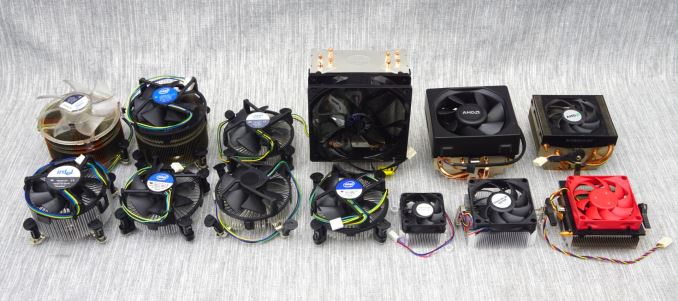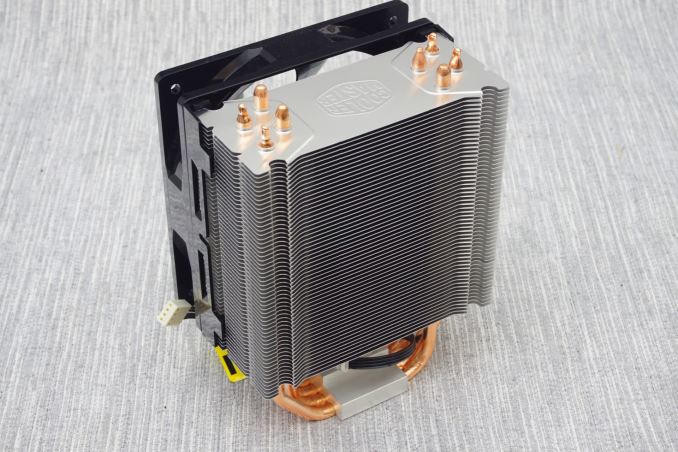Battle of The CPU Stock Coolers! 7x Intel vs 5x AMD, plus an EVO 212
by E. Fylladitakis on July 22, 2016 9:00 AM EST- Posted in
- Cases/Cooling/PSUs
- CPUs
- AMD
- Intel
- Cooler Master
- Cooler

Advanced PC users that like to care for their system commonly believe stock cooling solutions that are supplied with processors to be either barely adequate or too noisy even for a standard, unmodified system operating at stock frequencies. With bulk PC orders it is, of course, a difference scenario when every penny counts. But as a result of the perception of poor cooling from these 'default' coolers, most enthusiast users seek aftermarket cooling solutions. This has created a vast and multivariate demand, and there are so many companies offering such a wide variety of cooling products, from $20 all the way up to custom water cooling solutions. But is that really necessary for a mid-range build? We gathered together around a dozen stock coolers from across the years, from AMD and Intel, and pitted them against the highly rated EVO 212 from Cooler Master.
Introduction
Modern CPUs have become more efficient over time, and have begun to have lower cooling requirements. As a result, the CPU manufacturers have designed some rather advanced stock coolers and are either supplying them alongside their top-tier CPUs or selling them as aftermarket solutions. Despite the fact that these are the 'certified' coolers for the processors, the CPU manufacturer has to make millions, to every hundredth of a cent in manufacturing can be important to the bottom line. It is not easy for the average user to assess just how good the stock cooler really is and how much of an improvement, if any at all, there will be from the purchase of an aftermarket cooler. End users need to be aware of the performance of their current cooling solutions in order to reasonably assess the upgrade that will fit their needs.
In this review we will showcase the thermal performance of some popular stock CPU coolers of the last few years, including the controversial aftermarket Intel BXTS15A and the highly touted AMD Wraith. We also included one of the most popular mainstream coolers available, the Cooler Master EVO 212, as a baseline comparison against aftermarket solutions.
The coolers that we will be testing are in the following table, along with core/fin material listed, the size of the fan, and the overall mass of the cooler as measured on our units. Where heatpipes are in play, these are added into the Core section.
| Vendor | Cooler | Common Bundle | Core | Fins | Fan (mm) |
Mass (g) |
| Intel | D75716-002 | Socket 775 Celerons | Alu | Alu | 80 | 118 |
| C25704-002 | Socket 775 P4 6x0 | Cu | Alu | 80 | 132 | |
| E97378-001 | Socket 1155 Intel i5 | Cu | Alu | 80 | 146 | |
| E97379-001 | Socket 1155 Intel i3 | Alu | Alu | 80 | 92 | |
| D60188-001 | Socket 775, C2D E8x00 | Cu | Alu | 80 | 419 | |
| E31964-001 | Socket 1366 i7-X | Cu | Cu/Alu | 100 | 435 | |
| BXTS15A | Aftermarket, ≈$30 | Cu | Alu | 80 | 362 | |
| AMD | 1A213LQ00 | AMD “Kabini” AM1 | Alu | Alu | 50 | 75 |
| FHSA7015B | Several AMD Lines | Alu | Alu | 70 | 164 | |
| AV-Z7UB408003 | Black Edition Phenom | Alu +2 Cu HP |
Alu | 70 | 374 | |
| Wraith (125W) | AMD FX-8370 AMD A10-7890K |
Cu +4 Cu HP |
Alu | 90 | 304 | |
| Cooler Master | HK8-00005 | AMD FM2+ “Godavari” CPUs | Alu | Alu | 70 | 125 |
| EVO 212 | Aftermarket, ≈$30 | Cu +4 Cu HP |
Alu | 120 | 436 |











82 Comments
View All Comments
ZeDestructor - Monday, July 25, 2016 - link
Yes they could, but then you'd be reducing yields, which would drive final price up.pseudoid - Friday, July 22, 2016 - link
Did I miss the part about the SkyLake (LGA 1151) uPs? The Intel boxed Core I7-6700K Skylake uP comes with no cooling fan. I found that the Noctua coolers are a better fit for my needs, especially the iron-clad 3yr. warranty!LordanSS - Friday, July 22, 2016 - link
Thank you for this review.Although I already expected the 212 EVO to pull ahead (it's tough to match it on price/performance), was interesting to see the differences on the other stock ones. And the Wraith came out as a pleasant surprise.
Maybe in the US it's all about Intel and their CPUs, but in other areas of the world, like here in South America, AMD and their APUs are not doing poorly, with very good (local) pricing and decent enough performance for usual Office and light work cases, and people even use them for League of Legends and DotA2, which are very popular games around here, and not too graphics intensive.
zodiacfml - Friday, July 22, 2016 - link
I went to Intel's list of Skylake desktop CPU's and found only two that has around 90W of TDP.The 212 is only 25C above ambient at 150W.
Anything larger or more expensive than the 212 is pretty much overkill for modern CPUs.
wintermute000 - Friday, July 22, 2016 - link
"modern [Intel standard desktop] CPUs"FIFY
Ascaris - Sunday, July 24, 2016 - link
"modern [Intel standard desktop] CPUs at their stock clock and voltage settings"Byte - Saturday, July 23, 2016 - link
The hyper 212 is a bit overrated and dated, but then again i used it to test a bunch of 6700k i had fun delidding with liquid ultra and it kept them cool to 4.6/4.7GHz pretty easy.phylop - Saturday, July 23, 2016 - link
I would love to see you guys post an anthology of coolers throughout the ages. Include comparing how older coolers would perform on modern CPUs and vice versa.Teknobug - Saturday, July 23, 2016 - link
The 212 is probably the best bang per buck for HSF, can't go wrong with it. I also have a TX3 which is nearly as effective as the 212 and about $10 less, however there is one thing you must do if you're going to use it on an Intel system- ditch the flimsy black/white plastic locks and steal the ones from an Intel HSF to replace them with. Once you do that, you got a pretty solid HSF even for decently OC'd CPU's.Zap - Saturday, July 23, 2016 - link
IMO stock coolers are perfectly fine for systems that run stock speeds and aren't intended to sit running torture tests all day.Noisy? Did you enable "smart fan" in BIOS? Is that in normal use or hammering it with Prime95?
Bad temperatures? Did you install it properly? For whatever reason many people can't figure out push pins when they are super simple to use. Is your temperature "comfort level" calibrated for overclocks when you're just building a stock clocked system for family to use? Fact: Your stock clocked CPU does not require low temperatures.